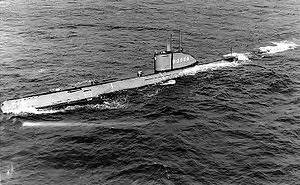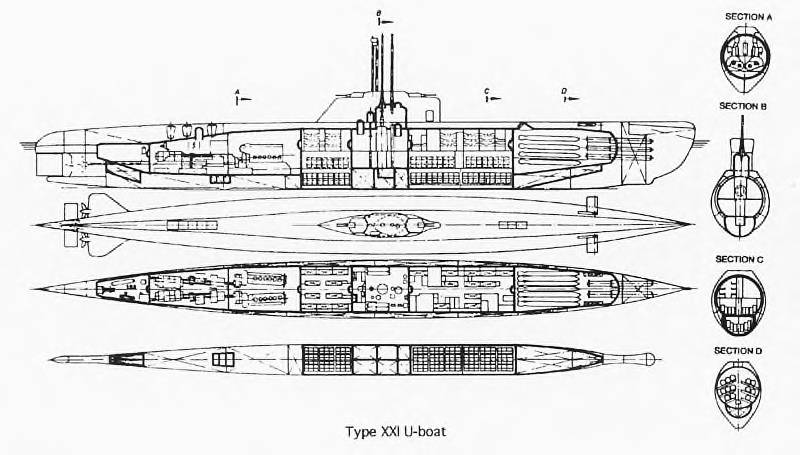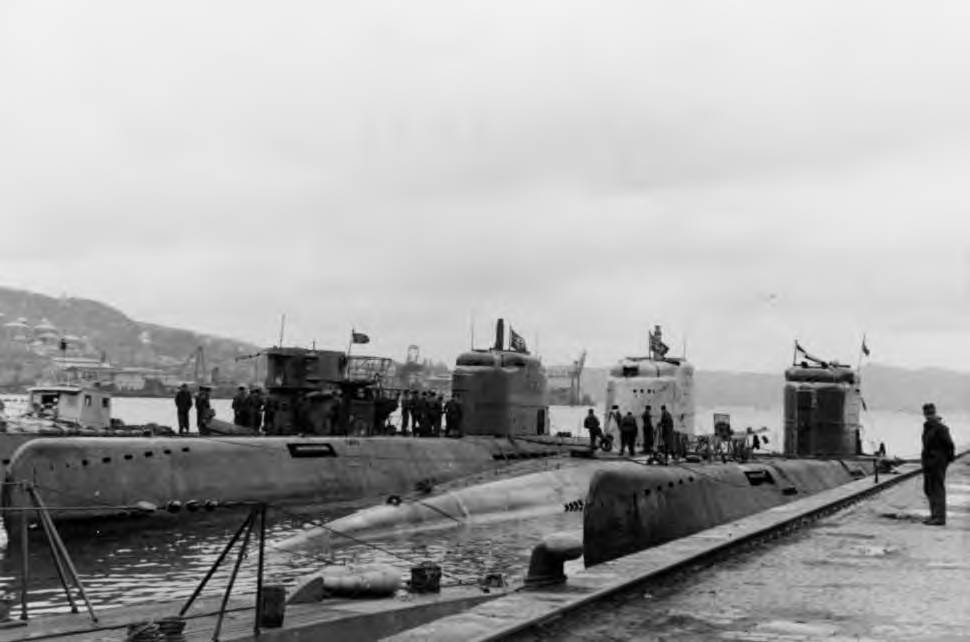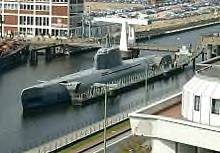Type XXI from
Wikipedia
| Type XXI U-boats, also known as "Elektroboote"
(electric boats), were the first submarines designed to operate primarily
submerged, rather than as surface ships that could submerge as a means
to escape detection or launch an attack.
Description
The key improvement in the Type XXI was greatly
increased battery capacity, roughly triple the Type VIIC. This gave these
boats great underwater range, and dramatically reduced the time spent on
or near the surface. They could travel submerged at about 5 kn (5.8 mph;
9.3 km/h) for two or three days before recharging batteries, which took
less than five hours using the snorkel. The Type XXI was also far quieter
than the VIIC, making it harder to detect when submerged.
The Type XXI's streamlined and hydrodynamically
clean hull design allowed high submerged speed. The ability to outrun many
surface ships while submerged, combined with improved dive times (also
a product of the new hull form), made it far harder to chase and destroy.
It also gave the boat a 'sprint ability' when positioning itself for an
attack. Older boats had to surface to sprint into position. This often
revealed a boat's location, especially after aircraft became available
for convoy escort. The new hull design also reduced visibility by marine
or airborne radar when surfaced; whether this was a goal of the design
or coincidence is still debated.
They also featured a hydraulic torpedo reloading
system that allowed all six bow torpedo tubes to be reloaded faster than
a Type VIIC could reload one tube. The Type XXI could fire 18 torpedoes
in under 20 minutes. The class also featured a very sensitive passive sonar
for the time.
The Type XXIs also had better facilities than
previous U-boat classes, including a freezer for food.
Construction
Between 1943 and 1945, 118 boats were assembled
by Blohm & Voss of Hamburg, AG Weser of Bremen, and F. Schichau of
Danzig. Each hull was constructed from eight prefabricated sections with
final assembly at the shipyards. This new method could have pushed construction
time below six months per vessel, but in practice all the assembled U-boats |

U-3008 in US service in 1948
| Name: |
Type XXI U-boat |
| Operators: |
Kriegsmarine
post was:
French Navy
German Navy
Royal NAvy
Soviet Navy
United States Navy |
| Completed: |
118 |
| Class & type: |
Submarine |
| Displacement: |
surfaced 1,621 ton |
|
submerged 1,819 ton |
| Length: |
76.7 m (251 ft 8 in) |
| Beam: |
8 m (26 ft 3 in) |
| Draught: |
6.32 m (20 ft 9 in) |
Speed - Surfaced:
Submerged: |
15.6 kn (28.9 km/h)
6.1 kn (11.3 km/h) |
| Range - Surfaced: |
15,500 nmi (28,700 km) at 5 kn |
|

US Navy diagram of a Type XXI U-boat |

Type XXI U-boats in Bergen, Norway |
were plagued with severe quality problems that
required extensive post-production work to fix. One of the reasons was,
as a result of Albert Speer's decision, sections were made by companies
having little experience in shipbuilding. As a result, of 118 Type XXIs
completed, only four were fit for combat before the war ended in Europe.
It was planned that final assembly of Type XXI
boats would eventually be carried out in the Valentin submarine pens, a
massive, bomb–hardened concrete bunker built at the small port of Farge,
near Bremen. Construction took place between 1943 and 1945, using around
10,000 concentration camp prisoners and prisoners of war as forced-labour.
The facility was 90% completed when, in March 1945, it was badly damaged
by Allied |
Grand Slam bunker buster bombs and abandoned. A few
weeks later, the area was captured by the British Army.
| Sensors
Radar Detector
The FuMB Ant 3 Bali radar detector an antenna
was located on top of schnorkel head.
Radar Transmitter
The Type XXI boats were fitted with the FuMO 65
Hohentwiel U1 with the Type F432 D2 radar transmitter.
|

Radar Transmitter
Type F432 D2 |
Wartime and post-war service
| Germany
U-2511 and U-3008 were the only Type XXIs to go
on war patrols, and neither sank any ships. U-2511 had a British cruiser
in her sights on 4 May when news of the German cease-fire was received.
She made a practice attack before leaving the scene undetected.
In 1957, U-2540, which had been scuttled at the
end of the war, was raised and refitted as research vessel Wilhelm Bauer
of the Bundesmarine. She was operated by both military and civilian crews
in a research role until 1982. In 1984, she was opened to the public by
the Deutsches Schiffahrtsmuseum (German Maritime Museum) in Bremerhaven,
Germany.
|

Wilhelm Bauer (U-2540) |
France
U-2518 became French submarine Roland Morillot.
She saw active service during the Suez Crisis in 1956, and remained in
commission until 1967. She was scrapped in 1969.
Soviet Union
Four Type XXI boats were assigned to the Soviet
Union by the Potsdam Agreement; these were U-3515, U-2529, U-3035, and
U-3041, which were commissioned into the Soviet Navy as B-27, B-28, B-29,
and B-30 (later B-100) respectively. However, Western intelligence believed
the Soviets had acquired several more Type XXI boats; a review by the U.S.
Joint Intelligence Committee for the Joint Chiefs of Staff in January 1948
estimated the Soviet Navy then had 15 Type XXIs operational, could complete
construction of 6 more within 2 months, and could build another 39 within
a year and a half from prefabricated sections, since several factories
producing Type XXI components and the assembly yard at Danzig had been
captured by the Soviets at the end of World War II. U 3538 -- U 3557 (respectively
TS-5 - TS-19 and TS-32 - TS-38) remained incomplete at Danzig and were
scrapped or sunk in 1947. The four boats assigned by Potsdam were used
in trials and tests until 1955, then scuttled or used for weapon testing
between 1958 and 1973. The Type XXI formed the basis for the Project 614,
essentially a copy of the Type XXI, and many of its characteristics were
also incorporated into the Project 613 submarine (known in the West as
the Whiskey class).
United Kingdom
The U-3017 was commissioned into the Royal Navy
as HMS N41. She was used for tests until being scrapped in November 1949.
United States
The United States Navy took over the U-2513 and
U-3008, operating them both in the Atlantic. In November 1946 President
Harry S. Truman became the first American President to travel on a submarine
when he visited U-2513, the submarine dived to 440 feet (130 m) with the
President on board. The U-2513 was sunk as a target in 1951; U-3008 was
scrapped in 1956.
Survivors
The only boat to survive intact is Wilhelm Bauer
(ex-U-2540). The wrecks of other Type XXI boats are known to exist. In
1985, it was discovered that the partially scrapped remains of U-2505,
U-3004, and U-3506 were still in the partially demolished "Elbe II" U-boat
bunker in Hamburg. The bunker has since been filled in with gravel, although
even that did not initially deter many souvenir hunters who measured the
position of open hatches and dug down to them to allow the removal of artifacts.
The wrecks now lie beneath a car park, making them inaccessible.
U-2513 lies in 213 feet (65 m) of water 70 miles
(110 km) west of Key West, Florida. The boat has been visited by divers,
but the depth makes this very difficult and the site is only considered
suitable for advanced divers. Four other boats lie off the coast of Northern
Ireland, where they were sunk in 1946 as part of Operation Deadlight. Both
U-2511 and U-2506 were found by nautical archaeologist Innes McCartney
during his Operation Deadlight expeditions between 2001 and 2003. Both
were found to be in remarkably good condition.
Influences
The Type XXI design directly influenced advanced
post-war submarines, the GUPPY improvements to the American Gato, Balao,
and Tench class submarines, and the Soviet submarine NATO reporting name
Whiskey and Zulu classes.
|